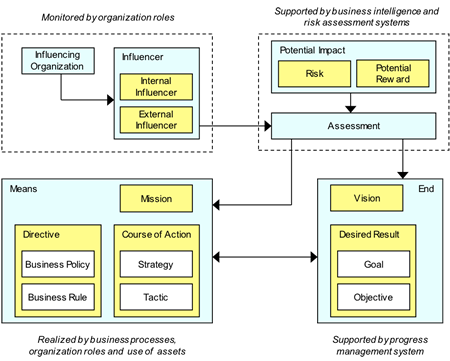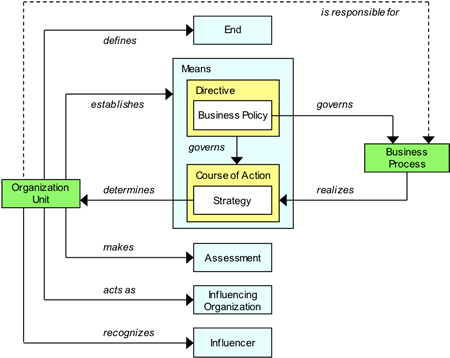The Business Motivation Model: An Introduction
The Getting of Wisdom
I think that most of us are familiar with the data/information/knowledge stack. Data typically consist of numbers, text, images, and so on. We create information by categorizing data and naming the categories, so that we can recognize that a given data item "19870326" is a date of birth rather than a purchase order number and "Rose Bush" is a person's name rather than a product description.
Knowledge is about relating information to the world it describes. When we see the information about a delivery, and its status is 'in transit', we know that the goods have left our warehouse but we don't yet have confirmation that the customer has accepted them. We also use knowledge in making decisions: we might look as Rose Bush's account history and decide to increase her credit limit.
We can add a fourth level: wisdom. Wisdom is the capability to apply knowledge effectively — to make good decisions; to determine whether risks are acceptable before taking them; to recognize when things aren't going as planned and take action to bring them back on course. This is the realm of the Business Motivation Model — the BMM.
The BMM won't make you wise, but it can support you as you become wiser through experience. How so?
What Is the BMM?
The BMM is an Object Management Group (OMG) specification. It was developed in the 1990s by the Business Rules Group (BRG)[1] and adopted by the OMG in 2005.[2]
The BMM's focus is support of business decisions made by business people about reacting to changes that affect their business — not just what the decisions are, but also why they are made. You would use it by obtaining a BMM tool and creating your own BMM, populating a BMM model with information about your business. There are two broad purposes:
- Capturing decisions about reaction to change and the rationale for making them. The intent is: (i) to make decisions visible to all the decision-makers involved, and (ii) to support improvement of decision-making by recording experience so that you can all learn from it.
- Providing references from the decisions to their effects on the operational business, such as changes made to business processes and organizational responsibilities.
A Vocabulary for Change Management
Even before you start using a BMM tool in your business, the BMM provides a useful vocabulary — twenty-two well-defined core concepts — for talking coherently about change management. You could, of course, change the terms used inside your business for these concepts but, for effective use of the BMM, it's best to stick with the BMM definitions for their meanings.
When developing the BMM, the Business Rules Group expected to be able to adopt standard industry definitions, but it was surprisingly difficult to find coherent, consistent glossaries — and impossible to find one that was generally accepted by industry. So, the BRG used a 'best of breed' approach for the core definitions and adapted them as needed to provide a coherent, consistent basic vocabulary.
How Does It Work?
The BMM provides support in four areas of activity defined in terms of the core concepts, as illustrated in Figure 1. The notation of the diagram is informal: nesting a box within another means "is a kind of" (e.g., 'Objective is a kind of Desired Result'), and an arrow connecting one box to another means 'depends on' (e.g., 'Assessment depends on Potential Impact'). The only core concept not shown in the diagram is Regulation, which has a special status as a kind of External Influencer.

Figure 1. Areas of activity supported by the BMM.
The BMM is not a methodology or a process. It does assume a typical cycle of activities:
- People in the business monitor Influencers that can cause changes that might affect the business;
- Changes that appear significant are notified to decision-makers, who make Assessments and decisions (including the possibility of 'no action'), taking account of related Influencers, and relevant earlier Assessments and the decisions made from them;
- Decisions are represented as Ends ("What states we want the business to be in, and when we want to reach them") and Means ("What we decided to do in order to reach those states");
- Realizing Means usually requires changes to the operational business — changing business policies, business processes, organizational responsibilities, and use of assets. Ends provide the completion and performance targets for the operational changes.
But the BMM doesn't prescribe how you should carry out these activities.
You would record Influencers, Assessments, and changes to Ends and Means in your BMM. This can support improved decision-making in two ways:
- You can make Assessments available to everyone in the business who has a stake in the opportunity or problem that has arisen, and capture all relevant concerns. Connecting related Influencers supports a broader context for making Assessments.
- Over time, you will build a history of decisions. Comparing defined Ends with actual outcomes from the operational business indicates how effective these decisions were. You can use this history in making new Assessments ("We've had similar situations in the past. What did we decide then? How well did it work?")
Operational Changes
As well as its core concepts, the BMM has a number of types of Placeholder, as illustrated in Figure 2. They serve to connect your BMM to your operational business.

Figure 2. Examples of BMM Placeholders.
In a BMM, Placeholders such as 'Organization Unit' and 'Business Process' are not specifications of actual organization units and business processes. Instead, they are references to where the actual organization units and business processes can be found in the operational business. The BMM requires only simple text descriptions, although you might choose to include, say, URIs within that text.
This loose coupling between the BMM and the operational business means that you can trace from the Influencer that caused a decision to the detail of resulting operational changes, without affecting the models and information systems used to manage the operational business. You might also choose to include backward references to your BMM in the change management system of your operational business.
The BMM also includes some connections between placeholders, such as the dashed line between 'Organization Unit' and 'Business Process'. They are not strictly necessary, since they replicate associations in the operational business, but are included for convenience.
Categorization
As well as explicit connections between core concepts — such as Assessment affects employment of Means, and Course of Action enables Course of Action — categorization is well supported in the BMM and supports flexible browsing and searching in BMM tools.
You can define your own categories of, say, Influencing Organization, and assign individual Influencing Organizations to multiple categories. The BMM provides suggested (typical) categories for Influencers and Assessments, which can be revised or replaced.
BMM Scope
You can have BMMs with different scopes. For example, your BMM:
- May be of the entire business, or an organization unit within it. Higher-level organization units may appear to a lower-level unit as Influencing Organizations, sitting outside the BMM scope. Directives from them may have the status of Regulations for the lower-level unit. (This is the special status of Regulation as a kind of External Influencer.)
- May support a 'steady state' business, where the business scope remains more-or-less constant but the business as a whole changes gradually over time in response to the Influencers, or a transition, such as acquisition of a competitor or adoption of a new delivery channel.
- Does not have to represent the entire business. From time to time you might want to create a BMM of a partial view, focused on particular issues (such as staff retention or exploitation of new technology).
In essence, the BMM applies wherever you want to apply the concepts of strategy. That could even be within a particular business initiative or change effort. How multiple BMMs of your business are related will depend on the capabilities of your BMM tools.
What Else?
Not much, actually. The BMM is just what it appears to be — a compact specification intended for business users, easy to understand, easy to use, and applicable to a range of business situations.
Addendum: BMM Core Concepts
Informal descriptions of the core concepts are given below. For the formal definitions, download the specification and see Section 9: Concepts Catalog.[1]
Influencer
An Influencer is something that a business decides might affect it. There are two broad types:
- Internal Influencer: from within the business (e.g., resource quality, infrastructure, culture).
- External Influencer: from outside the business (e.g., customer, regulation, competition).
Influencers may (or may not) originate from recognized Influencing Organizations, such as regulators or competitors.
Influencing Organization
An organization that is the source of Influencers (e.g., regulator, competitor, market analyst)
Assessments
When an Influencer causes a significant change, the business makes an Assessment of its Potential Impacts. There may be multiple Assessments, perhaps from different stakeholders.
Assessments take account of relevant earlier Assessments and decisions recorded in the BMM, and of other Influencers related to the one causing the change. Assessments are supported by whatever business intelligence and risk analysis systems the enterprise has. The BMM entry for an assessment includes references to the detail that supports it — reports, studies, simulations, etc. — rather than containing the detail itself.
The outcomes of an Assessment are decisions about Ends and Means.
Potential Impact
A Potential Impact is an evaluation that quantifies or qualifies some aspect of an Assessment. There are two kinds:
- Potential Reward: estimate of the probability of a benefit of some kind and its probable impact on the business.
- Risk: estimate of the probability of loss of some kind and its probable impact on the business.
Ends
Ends define what a business wants to be — the states it desires to be in:
- Vision (optional): an easily-understood summary of what the business considers itself to be, or aspires to be. All objectives and goals should support (or, at least, not contradict) the vision.
- Desired Results, which are of two kinds:
- Goal: a business state or condition to be maintained or approached in the medium to long term, e.g., "To be one of the top three suppliers (by turnover) in our market."
- Objective: a measurable, time-targeted step towards one or more goals, e.g., "To increase year-on-year turnover by 2% in the current financial year." Required or expected values of key performance indicators are recorded as objectives, although not all objectives are based on key performance indicators.
Desired Results are supported by whatever progress management system the business has. The BMM entry for a desired result includes references to the detail that supports it, rather than containing the detail itself.
Means
Means define what a business has decided it will do to achieve its Ends. There are three kinds:
- Mission (optional): the business's primary activity to realize its Vision. How it is carried out is defined in its Courses of Action.
- Course of Action: what the business has decided to do in support of one or more of its Goals. There are two kinds:
- Strategy: a major part of the plan to accomplish the mission, usually long-term and with a significant impact on how the business operates, e.g., "Focus on repeat business from corporate customers."
- Tactic: a Course of Action that supports one or more Strategies — narrower in scope than a Strategy and may be short-term. For example, "Provide personal incentives for corporate bookings."
- Directive: governs what Courses of Action can and should be adopted, and how they must or may be realized. There are two kinds:
- Business Policy: a broad directive that needs further interpretation (in Business Rules) in order to be put into practice, e.g., "Loans must be repayable." Business Policies may be documented in a business's BMM, or in a separate policy management system.
- Business Rule: reference to a rule in the operational business, e.g., "A home mortgage must not be for more than 4 x the borrower's salary." Business Rules make Business Policies practicable, and guide business processes.
There is no hard and fast distinction between Strategy and Tactic; it will vary from business to business.
The BMM entry for a Course of Action provides a summary description of the Course of Action, plus Placeholder references to where in the operational business the Course of Action is realized — business processes, responsibilities assigned to organization roles, deployment of assets and resources, etc.
References
[1] The Business Rules Group (BRG), visit www.businessrulesgroup.org/bmm.shtml ![]()
[2] Object Management Group (OMG), visit www.omg.org/spec/BMM/1.1
Like all OMG specifications, it can be downloaded and used with no charge. ![]()
# # #
About our Contributor:
Online Interactive Training Series
In response to a great many requests, Business Rule Solutions now offers at-a-distance learning options. No travel, no backlogs, no hassles. Same great instructors, but with schedules, content and pricing designed to meet the special needs of busy professionals.














